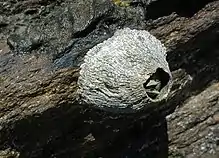Thecostraca
Thecostraca is a subclass of marine invertebrates containing about 1,320 described species. Many species have planktonic larvae which become sessile or parasitic as adults.
| Thecostraca | |
|---|---|
 | |
| A barnacle of the family Balanidae, Mission Beach, Queensland, Australia, 2001. | |
| Scientific classification | |
| Kingdom: | |
| Phylum: | |
| Subphylum: | |
| Class: | |
| Subclass: | Thecostraca Gruvel, 1905 |
| Infraclasses | |
The most important subgroup are the barnacles (infraclass Cirripedia), constituting about 1,220 known species.[1]
The subgroup Facetotecta contains a single genus, Hansenocaris, known only from the tiny planktonic nauplii called "y-larvae". These larvae have no known adult form, though it is suspected that they are parasites, and their affinity is uncertain. Some researchers believe that they may be larval tantulocaridans. No larval tantulocaridans are known, so this would solve two puzzles at once.[2]
The group Ascothoracida contains about 100 species, all parasites of coelenterates and echinoderms.[3]
Classification
This article follows Martin and Davis in placing Thecostraca as a subclass of Maxillopoda and in the following classification of thecostracans down to the level of orders:[2]
Subclass Thecostraca Gruvel, 1905
- Infraclass Facetotecta Grygier, 1985
- Infraclass Ascothoracida Lacaze-Duthiers, 1880
- Order Laurida Grygier, 1987
- Order Dendrogastrida Grygier, 1987
- Infraclass Cirripedia Burmeister, 1834
- Superorder Acrothoracica Gruvel, 1905
- Order Pygophora Berndt, 1907
- Order Apygophora Berndt, 1907
- Superorder Rhizocephala Müller, 1862
- Order Kentrogonida Delage, 1884
- Order Akentrogonida Häfele, 1911
- Superorder Thoracica Darwin, 1854
- Order Pedunculata Lamarck, 1818
- Order Sessilia Lamarck, 1818
- Superorder Acrothoracica Gruvel, 1905
References
- Martin Walters & Jinny Johnson (2007). The World of Animals. Bath, Somerset: Parragon. ISBN 978-1-4054-9926-2.
- Joel W. Martin & George E. Davis (2001). An Updated Classification of the Recent Crustacea (PDF). Natural History Museum of Los Angeles County. pp. 132 pp.
- Paul Schmid-Hempel (2011). "The diversity and natural history of parasites". Evolutionary Parasitology: the Integrated Study of Infections, Immunology, Ecology, and Genetics. Oxford University Press. pp. 18–51. ISBN 978-0-19-922949-9.
External links
 Data related to Thecostraca at Wikispecies
Data related to Thecostraca at Wikispecies
